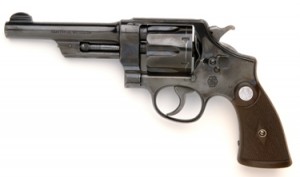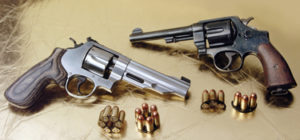

Smith & Wesson introduced their first large frame (referred to as the N-frame), swing-out cylinder, DA revolver, the .44 Hand Ejector – also known as the ‘Triple Lock” or “New Century” – in 1907 to compete with Colt’s New Service revolver.
Up until this time all of S&W’s large-caliber revolvers had been of the hinged-frame, top-break variety, and, while popular, they were never viewed as quite rugged enough or chambered for powerful enough cartridges to be a real threat to Colt’s predominance in the American military and civilian markets. S&W brought out their first swing-out cylinder revolver, the .32 Hand Ejector, in 1896 followed by the 38-caliber Military & Police revolver in 1899.

The .44 Hand Ejector used the same basic mechanism as these smaller caliber revolvers. The cylinder was locked by a rod that passed through the ejector system and latched into a recess on the face of the breech while a second lock was provided by a spring loaded stud in a lug underneath the barrel that snapped into the forward end of the ejector rod.
But S&W felt that a stronger system would be required with the powerful cartridges they intended to use, so additional locking was provided by a bolt housed in the ejector rod shroud that locked into a mortise on the cylinder yoke. The .44 Hand Ejector could be ordered with 4-, 5-, 6- or 6.5-inch barrels, with wooden or hard rubber grips and a choice of blue or nickel finish.
S&W also introduced a new cartridge that was to become as famous, if not more so, than the revolver itself: the .44 S&W Special. This was based upon their popular .44 Russian but used a case 0.2 inch (5mm) longer and loaded a 246-gr. lead bullet moving at 755 fps. In addition to becoming popular for law enforcement and self defense, it quickly earned a reputation for accuracy and preempted the .44 Russian as the dominant target shooting cartridge of the day.
While .44 Special guns accountedfor the majority of sales, the Triple Lock revolver was alsooffered chambered for the .44-40,.45 Colt and, for the British market,.450 Boxer and .455 Webley.When World War I broke out in1914, the British government placedlarge orders with S&W for revolvers.In addition to producing purpose-built .455 revolvers, many 44-caliber gunswere retrofi tted with .455 cylinders andbarrels to supply the anxious British.
But in the brutal conditions of trenchwarfare it became obvious that the Triple Lock was far too fi nely made arevolver: the third lock and the ejector rod shroud often became clogged withmud or debris, preventing the cylinderfrom closing.
S&W rectified these problems by thesimple expedient of removing the offending parts. The modified revolver, dubbed the .455 Hand Ejector, Second Model or.455 Hand Ejector, Mark II, went into production in 1915. All British issue MarkIIs had 6.5-inch barrels and boasted a commercial-grade blued finish. The big Smith proved popular and by 1918 more than 68,000 had been supplied to Britishand Canadian forces.
As it became obvious that the United States would soon be entering the conflict on the Allied side, the U.S. Army began casting about for additional weapons and while they were committed to the 1911 Colt pistol, it soon became obvious that not enough could be produced to meet demand. In 1916, the Army approached S&W about a “substitute standard” handgun and were offered the Hand Ejector, Second Model.

But while the Army was not adverse to using revolvers they insisted upon one precondition: any substitute standard handgun MUST use the issue .45 ACP cartridge!
This presented a problem as the rimless ACP cartridge would not function with the standard revolver ejector system. Working in conjunction with Springfield Armory, S&W’s engineers developed what has become known as the “half moon clip,” a semicircular piece of flat stamped steel with cutouts into which three rimless .45ACP cartridges could be snapped.
This allowed the rimless cases to be ejected by the extractor bearing on the clip and had the secondary advantage of allowing very fast reloading. The only modifications required to the design were a shorter cylinder to provide clearance for the half moonclips and wider cylinder stop stud to keep the cylinder in place when swung open. When the U.S. declared war on April 2, 1917, S&W began production and delivered the first Smith & Wesson Revolver, Caliber .45, Model 1917 on September 6, 1917.
While the Army’s original intention was to issue these revolvers to rear echelon and support troops, shortly after the first M1917s reached France, they began appearing in the trenches. It proved to be a rugged, powerful fighting handgun capable of standing up to the vile conditions of trench warfare with aplomb and were soon much in demand by American doughboys.
By the time contracts were canceled in 1918, S&W had delivered 163,476 Model 1917 revolvers to the U.S. Army.
Click Here to Read Part II
Click Here to Read Part III
This article is an excerpt from the new Gun Digest 2011 annual book.

Next Step: Get your FREE Printable Target Pack
Enhance your shooting precision with our 62 MOA Targets, perfect for rifles and handguns. Crafted in collaboration with Storm Tactical for accuracy and versatility.
Subscribe to the Gun Digest email newsletter and get your downloadable target pack sent straight to your inbox. Stay updated with the latest firearms info in the industry.

![Best Concealed Carry Guns In 2025 [Field Tested] Wilson Combat EDC X9S 1](https://gundigest.com/wp-content/uploads/Wilson-Combat-EDC-X9S-1-324x160.jpg)


![Best 9mm Carbine: Affordable PCCs [Tested] Ruger Carbine Shooting](https://gundigest.com/wp-content/uploads/Ruger-Carbine-Shooting-100x70.jpg)
![Best AR-15: Top Options Available Today [Field Tested] Harrington and Richardson PSA XM177E2 feature](https://gundigest.com/wp-content/uploads/Harrington-and-Richardson-PSA-XM177E2-feature-100x70.jpg)

Can you recommend where i can find good replacement walnut grips for the Smith and Wesson U.S. army M1917 45.? And please don’t recommend Gungrip.com. I recieved a pair from there and they were poor fitting to say the least and they were not as shown in the picture. The guy who you talk to always hangs up on you while your still talking and trying to convey the problem. I wouldn’t recommend this place to anyone.